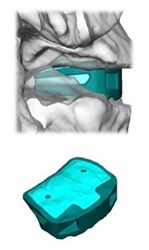World's First 3D Printed Titanium Cervical Implant Operation Successful

A team of surgeons in Germany has performed the first spinal fusion operation implanting an individualized cervical implant made from 3D printed titanium. The implant’s design and manufacture was the result of a collaboration between EIT Emerging Implant Technologies GmbH (EIT) and 3D Systems.
According to CBS News, the number of spinal fusion surgeries performed annually in the United States increased by 70 percent between 2001 and 2011, an increase attributed to advances in technology and an aging population with a lower tolerance for decreased mobility.
While innovations in spinal surgery have progressed, traditional methods that use bone grafts and metal hardware are susceptible to complications like hardware fracture and implant migration. These complications, according to the University of Maryland Medical Center, are frequent causes of spinal reoperation.
Scientists at EIT hoped to reduce reoperation rates by developing a 3D printed and anatomically adapted implant that is custom-made to fit each patient’s spine. The EIT Cellular Titanium with micro-, macro-, and nano-structural features was designed to “provide optimal biomechanical and biological environment for natural bone ingrowth.”
The implant is manufactured using a selective laser melting (SLM) technique to shape biocompatible titanium, which has 80 percent porosity, providing scaffolding for growing bone cells and vascular structures in a way that mimics trabecular bone structure. These features, said the developers, provide excellent bone-implant contact and negate the need for a bone graft.
Because the implant is specially designed and printed for each patient, scientists say it is less likely to shift around, to destroy the structural integrity of surrounding bone, or to suffer delays in fusion that are common in standard implants because of insufficient bone-implant contact.
“In two to three years, we will be able to provide individualized series implants at reasonable cost. Individualization will deliver better implants, faster and easier surgery, and better patient outcome. The reoperation rates in spine surgery are by far higher than, for example, with hip or knee implants. It is our mission to change this,” said Stephanie Eisen, CEO of EIT, in a press release.
While 3D printed titanium is relatively new to the biomedical industry, it is swiftly attracting interest. Researchers at the Royal Melbourne Institute of Technology (RMIT) are developing methods to 3D print titanium bone that can replace segments lost to cancer. Also, last year, doctors at St. Vincent’s Hospital in Victoria implanted the world’s first titanium printed heel.
“We are fascinated by the possibilities of this new technology combining modern computer-aided design and custom-made manufacturing of a high-tech cervical implant,” said Uwe Spetzger, professor and chairman of the department of neurosurgery at Klinikum Karlsruhe, and the surgeon who performed the spinal fusion operation. “The future of patient individualized spinal implants has begun.”
